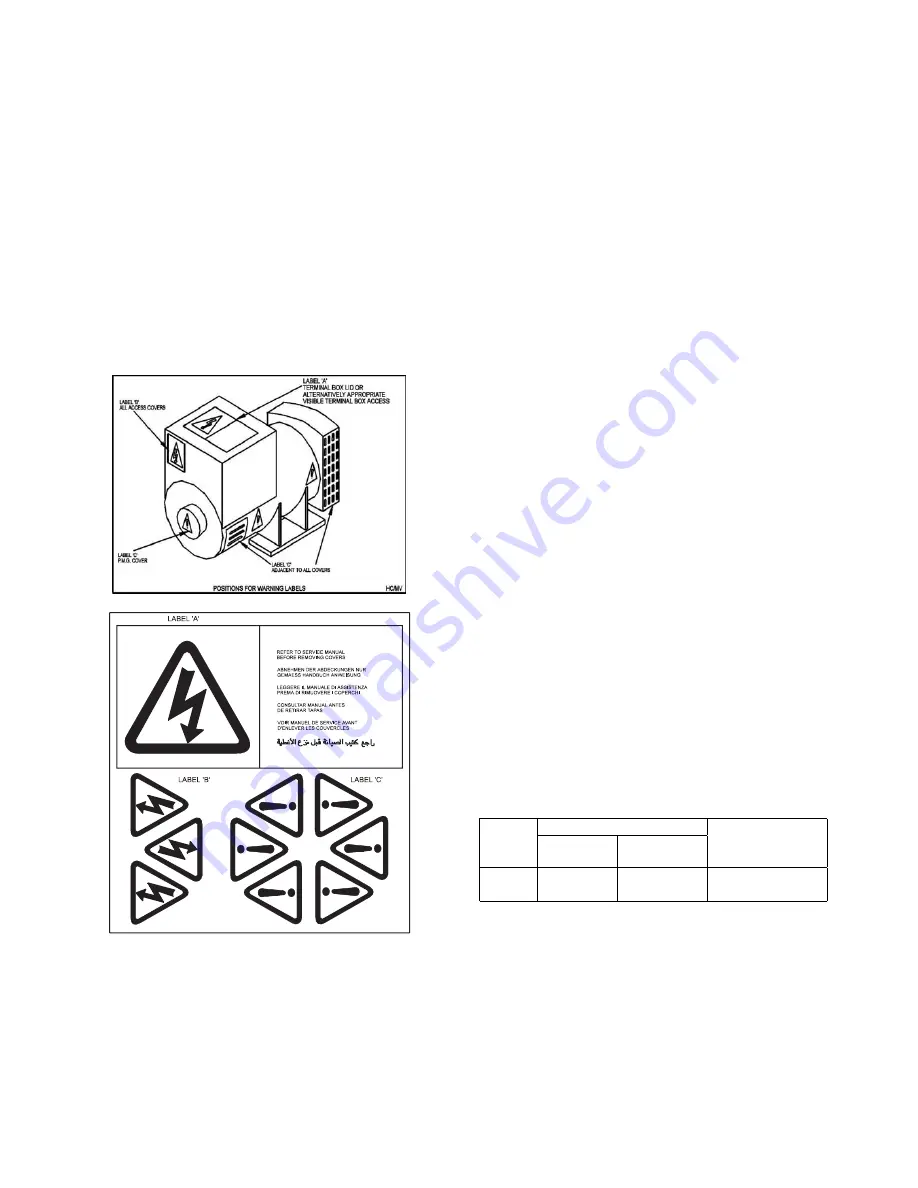
5
SECTION 3
APPLICATION OF THE GENERATOR
The generator is supplied as a component part for
installation in a generating set. It is not, therefore, practicable
to fit all the necessary warning/hazard labels during
generator manufacture. The additional labels required are
packaged with this Manual, together with a drawing
identifying their locations. (See below).
Information labels regarding bearing type, bearing grease,
and re-lubrication information have been fitted to each end
plate adjacent to bearing.
It is the responsibility of the generating set manufacturer to
ensure that the correct labels are fitted, and are clearly
visible.
The ambient conditions in which a generator is operated or
stored should be fully understood, to ensure the generator is
maintained in a fully serviceable condition. Areas for
consideration include temperature, humidity and even
vibration levels.
Temperatures should be stable, but if combined with high
humidity levels, anti-condensation heaters should be
connected to a suitable single phase mains supply. Within
the generator's storage or installed area, thermostatic control
of space heaters will be of considerable assistance.
If the generator is subjected to conditions which result in
condensation forming within the generator, steps must be
taken to ventilate and heat the generator. The winding
insulation resistance must be measured and be above the
minimum values stated in section 4.4.1.1 of this book before
the generator is put into service.
Subjecting stationary generators to vibration will cause
damage to the generator ball bearings, the process termed
brinelling.
The generators have been designed for use in a maximum
ambient temperature of 40°C. in accordance with B.S. 5000.
Ambients in excess of 40°C. can be tolerated with reduced
ratings - refer to the generator nameplate for rating and
ambient. In the event that the generator is required to
operate in an ambient in excess of the nameplate value or at
altitudes in excess of 1000 metres above sea level, refer to
the factory.
The generators are of air-ventilated screen protected drip-
proof design and are not suitable for mounting outdoors
unless adequately protected by the use of canopies. Anti-
condensation heaters are recommended during storage and
for standby duty to ensure winding insulation is maintained in
good condition.
When installed in a closed canopy it must be ensured that
the ambient temperature of the cooling air to the generator
does not exceed that for which the generator has been rated.
The canopy should be designed such that the engine air
intake to the canopy is separated from the generator intake,
particularly where the radiator cooling fan is required to draw
air into the canopy. In addition the generator air intake to the
canopy should be designed such that the ingress of moisture
is prohibited, preferably by use of a two stage filter.
The air intake/outlet must be suitable for the air flow given in
the following table with additional pressure drops less than or
equal to those given below:
Air Flow
Frame
50Hz
60Hz
Additional
(intake/outlet)
Pressure Drop
8
4.1m
3
/sec
(8680cfm)
4.8m
3
/sec
(10170cfm)
6mm water gauge
Important !
Reduction in cooling air flow or
inadequate protection to the
generator can result in damage
and/or failure of windings.
Dynamic balancing of the generator rotor assembly has been
carried out during manufacture in accordance with BS 6861
Part 1 Grade 2.5 to ensure vibration limits of the generator
are in accordance with BS 4999 Part 142.







































